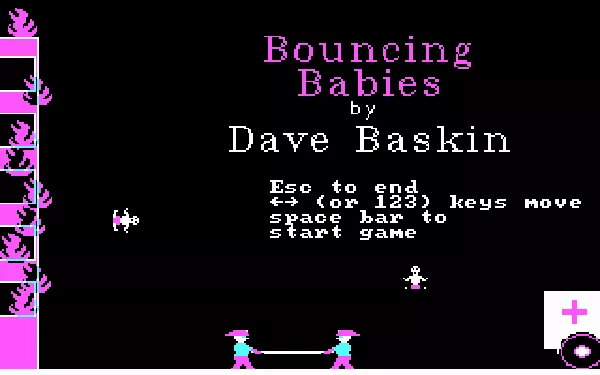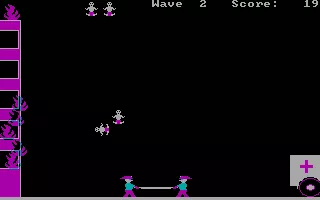Bouncing Babies
Description
A building is on fire and you have to rescue babies jumping (jumping?) from the building. A two man fire fighter team is the only thing between life and certain death for the bouncing babies. Use the fire fighter stretcher/trampoline to bounce the babies safely into the ambulance. The gameplay is based on a Game & Watch game called Fire.
The game has only three keys to play (1, 2, 3) which represents the positions where you can place your fireman team: left, middle, or right. Anticipate where the babies will fall from their jumping angle. Multiple and faster babies will jump off the building as you advance in the game.
Groups +
Screenshots
Credits (DOS version)
| Written by |
Reviews
Players
Average score: 2.9 out of 5 (based on 7 ratings with 2 reviews)
The Good
I'm not referring to the thriller as a narrative genre, although Bouncing Babies could also qualify, with its main subjects looking more like Edvard Munch's The Scream than actual human infants. What I'm referring to is Michael Jackson's 1982 album, which the game might have come close to in terms of simply being everywhere. If you were around in the '80s, and your household had a turntable or a cassette player, more likely than not it also had a copy of Thriller. Similarly, if you lived anywhere near an IBM-compatible PC, at any time during the decade, chances are a copy of Bouncing Babies was not far away.
This is what happened when you wrote a game for the IBM PC in the first half of the 1980s, and decided that you'd give it away for free and let people copy it to their friends. For many years, the PC platform was starved for games, when compared to other home computers of the time. It simply wasn't the machine you got when you wanted to play computer games, especially graphical ones. But if an IBM PC was what you had, actually finding games for it was all the more satisfying. Any game that was free to copy, and not completely unplayable, in that time would reach a market penetration that is unheard of ever since (quite often hand in hand with some boot sector virus, that came with the territory of disks whose labels just showed a hastily scribbled "GAMES"). That's why this quick, simple, tiny 37 kB Freeware DOS game is, for a certain generation, as universally known as barely any other. Its bizarre premise surely helped keep it in memory.
The gameplay is lifted directly from Nintendo's Game & Watch LCD game Fire, in which people jump out of a burning building, and players have to use a trampoline-like blanket carried by two firefighters, in order to "bounce" them to the safety of an ambulance. Why Bouncing Babies author Dave Baskin decided to turn the jumpers into babies might be a mystery forever lost to history. Any explanation seems as likely as that he just drew up some humanoid figure, and ended up deciding that they looked a bit like babies. The game could also have been called Bouncing Meditating People, and it would have fit just as well. A glance at the size of the ambulance's wheels is enough to confirm that drawing was not his primary skill. The chubbiness and diapers of the babies does, as morbid as it is, make them seem nicely bouncy, though.
That is helped by the satisfying sound effects, in particular the bouncing chirp. It's as loud and grating to the ear as any basic PC speaker sound, but few of these early games achieved sounds this fitting and memorable. People who haven't seen the game in 30 years would probably still have flashbacks to it today, if you played back the chirruping to them. It's in a memorability league of its own!
The controls are also well thought-out. You can use your left and right arrow keys to move between the three positions in which you'll have to catch the babies, which might seem like the most obvious choice. However, you can also choose the three positions directly by using the number keys 1–3, regardless of where your firefighters are currently standing. Once you reach later stages of the game, you'll start to appreciate this increased efficiency. This is what happens when a programmer not only finishes his game, but also playtests it, or has it playtested, and adds little comfort features.
The game starts out slow, although the babies drop and bounce always at the same speed. It's the number of babies, and the rate that they're jumping at, that increases over successive waves. The progression works well, and things get challenging fast. I appreciate that the actual times at which babies appear are random, so there are no patterns you can learn by heart. In turn, your score is somewhat dependent on luck. You might get a very unfairly timed jump in wave 2, that almost forces you to miss. But you might also be lucky and sail through some very calm waves and reach a higher score more easily.
The Bad
What I don't quite get is why the first wave was made so long. In wave 1, babies drop one at a time, so you never have to multitask and hurry back and forth. It's very straight-forward, which would work as a warm-up phase, but having to save 13 babies like that, one after the other, is too long. The challenge really only starts in wave 2.
Then there's the issue of rough motion. If one were to implement this game today, the babies would drop and bounce in smooth trajectories that let you clearly see and estimate where they're heading. In Bouncing Babies, they are drawn only in a limited number of fixed positions. The lack of smooth motion makes it a lot more difficult to determine which babies are imminently hitting the ground. Most likely, this is a concession to the speed you can get out of graphical games written in BASIC. But you could also argue that this way, it's more faithful to the original LCD game, where the jerky trajectories are mainly down to hardware limitations. Either way, it's part of the game, and something that probably wasn't this obvious in 1984.
Finally, the game is notoriously one of those titles whose speed of gameplay is directly tied to the speed of computation. Meaning, a faster CPU makes the game run much faster and become much more difficult. I'm not sure what possibilities there were for IBM PC BASIC games to even prevent this, if they could access a sufficiently precise real-time clock to adapt to different CPU speeds. This lead to problems even back in the day, as CPUs kept getting faster. Some might even remember Bouncing Babies only as that unplayably fast thing. When it came out in 1984, all official IBM PC models were still clocked at 4.77 MHz, and that seems to be the speed the game was optimized for. For you modern players trying to play this on DOSBox: a cycles value of 315 seems to approximate the correct speed relatively well.
The Bottom Line
Obviously, I quite like Bouncing Babies. I also don't manage to play it for more than a few minutes at a time, especially these days. But that is more than most PC action games from the '80s will get out of me. It's simply a well-implemented game that doesn't pretend to be more than it is. With so many games written in BASIC trying, and failing miserably, to replicate real arcade video games, Baskin found a much more appropriate goal in replicating a Game & Watch title. In return, the game does not feel sluggish or limited. It works for what it is. The chances that you're going to get addicted to it are slim, but quite real that you might want to keep trying to beat your own high score for a while. Mine is 52. Let's bounce!
DOS · by Daniel Saner (3517) · 2021
Boing...boing...boing...splat! (oops!)
The Good
This game kinda changed my views about being a fireman one upon a time...hehe. Back then bouncing babies was quite addictive...although due to its repetitive form and the the confusion of total chaos watching one too many babies do daring superhuman leaps in the air at the same time, made addiction last only for an hour.
This game did test your eye coordination and finger movement to the limit...especially your capabilities to handle situations under total stress...boy, did I do miserably.
One great thing about the game though is the sound. It's interesting to hear the PC speaker describe the sound of "Boing" as the babies bounce off the fireman trampoline. It creates a certain ring to it after a while.
The Bad
One, two, six babies I can handle. But more than that? Come on...Dang there a lot of babies flying about. You can't help but stop and think out of curiosity why the mother never practiced birth control...
The moral dilemma of missing one of those babies is too much (splat!). Ooooh...that's gotta hurt! The thing about most PC booter games, is the more difficult the game, the faster the speed and in this case the more "superboys" bouncing around...I wonder if there is such thing as a limit?
The Bottom Line
All hail the fireman! Baby boom is an understatement.
DOS · by Indra was here (20735) · 2004
Analytics
Related Sites +
-
Crap Shoot
A humorous review on PC Gamer
Identifiers +
Contribute
Are you familiar with this game? Help document and preserve this entry in video game history! If your contribution is approved, you will earn points and be credited as a contributor.
Contributors to this Entry
Game added by Indra was here.
Additional contributors: Patrick Bregger.
Game added June 27, 2003. Last modified August 17, 2023.













